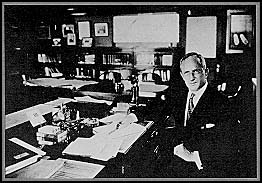Holland Tunnel
|
|
The Holland Tunnel, originally known as the Hudson River Vehicular Tunnel or the Canal Street Tunnel, is one of two highway tunnels under the Hudson River connecting the island of Manhattan with New Jersey.
Begun in 1920 and completed in 1927, it is named after Clifford Milburn Holland (1883 - 1924), Chief Engineer on the project, who died before it was completed. The tunnel is one of the earliest examples of a ventilated design, having 80 ft (24 m) diameter fans blowing air in one series of ducts and out another series. Ventilation was required by the advent of the automobile and associated carbon monoxide exhaust.
The world's first major ventilated highway tunnel, the Holland consists of a pair of tubes, each providing two lanes in a twenty foot roadway width. The north tube is 8,558 ft (2.61 km) from end to end, while the south tube is slightly shorter at just 8,371 ft (2.55 km). Both tubes are situated in the mud beneath the river, with the lowest point of the roadway approximately 93 feet (28 m) below mean high water. A nine-lane toll plaza is located on the New Jersey side of the tunnel, and (as of 2003) charges $6 for cars and $5 for motorcycles for passage from New Jersey to New York (there is no toll in the opposite direction.) Discounts are available for E-ZPass users. According to the Port Authority of New York and New Jersey, which controls the tunnel, traffic for 2002 totalled 15,764,000 vehicles, and 33,926,000 vehicles in 2004.
History
The concept for what would become the Holland Tunnel was developed in 1906 by a joint commission between New York and New Jersey. The commission initially considered building a bridge for cost reasons, but this plan was abandoned in favor of a tunnel in 1913 when it was determined that the cost of land for accessways to a suitably raised bridge would be prohibitive (a height of 200 feet (60 m) was considered the minimum necessary to avoid interfering with shipping.)
 |
Clifford Milburn Holland, 1919 |
Over the next several years, a number of design proposals were evaluated for the new tunnel. The first two called for a single tube containing two levels of traffic. One, authored by engineer George Goethals specified that traffic on each level would travel in a different direction. The other, by the firm Jacobs and Davies, called for a slightly different tube diameter, with an "express" level and a level for slower traffic. Both designs were eventually passed over in favor of a new type of design proposed by engineer Clifford Milburn Holland, in which two separate tubes would each contain two lanes both going in the same direction. Holland's proposal was adopted, and he was named Chief Engineer of the project.
Work on the tunnel, officially designated the "Hudson River Vehicular Tunnel Project", began in October 1920. In 1924, the day before the two halves of the tunnel were scheduled to be linked, 41 year old Holland died during a tonsillectomy at a health center in Battle Creek, Michigan. Holland was succeeded by Milton H. Freeman, who also died after several months on the job. After Freeman's death, the position was occupied by Ole Singstad, who oversaw the completion of the tunnel and designed its pioneering ventilation system.
Tunnel construction required workers to spend large amounts of time under high pressure, which was necessary to prevent river water from entering prior to completion of the tubes. "Sandhogs", as they were termed, entered the tunnel through a series of airlocks, and could only remain inside of the tunnel for a designated time period. On exiting the tunnel, the workers were required to undergo controlled depressurization in order to avoid the bends, a condition in which nitrogen bubbles form in the blood. Fortunately, no workers died as a result of depressurization.
Completion of the tunnel took nearly seven years, and the lives of thirteen workers. Opened on November 13, 1927, the tunnel was an immediate success. On its first day of operation, 51,694 vehicles passed through, each paying a 50 cent toll, which was intended to defray the tunnel's $48 million price tag. In 1931 the tunnel was passed to the Port Authority of New York and New Jersey, which continues to operate it today. Excluding the initial $48 million in construction, the Port Authority notes $378,057,000 of cumulative capital investment as of 2003.
Horse-drawn vehicles have always been banned from the tunnel. It was planned a few months before opening for pedestrians to be allowed at a toll described as "not encouraging", but no mention of this is made upon opening.
In 1949, a fire aboard a chemical truck caused enormous damage to the south tube of the tunnel. Although nobody was killed, the fire resulted in 66 injuries and nearly $600,000 worth of damage to the structure. As a result, the Port Authority adopted a strict series of rules on the transportation of hazardous materials.
Following the September 11, 2001 Terrorist Attack on the World Trade Center, the tunnel remained closed to all but emergency traffic for nearly a month. When it reopened, strict new regulations were enacted banning single-occupant vehicles and trucks from entering the tunnel. It wasn't until November 17, 2003 that the single occupancy vehicle restrictions were lifted. Tractor trailers and trucks in classes four, five, and six (four, five, and six-axle trucks) are still prohibited from using the tunnel.
Movies
Although the tunnel in the 1996 Sylvester Stallone movie Daylight is never named (to avoid libel accusations by the Port Authority), the movie is set in a tunnel based on the Holland Tunnel.
External links
- Port Authority of New York & New Jersey (http://www.panynj.gov/)
- Holland Tunnel from NYCRoads.com (http://www.nycroads.com/crossings/holland/)
